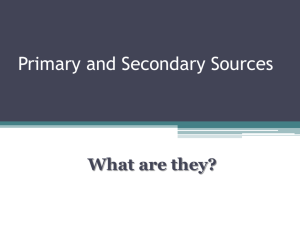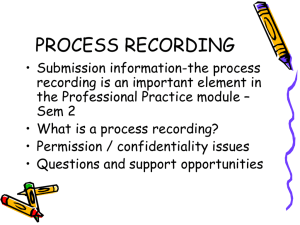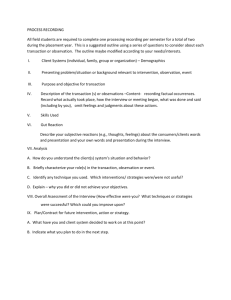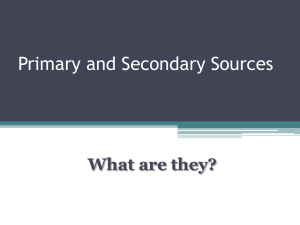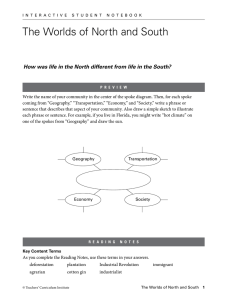WHAT ARE PRIMARY AND SECONDARY SOURCES?
advertisement
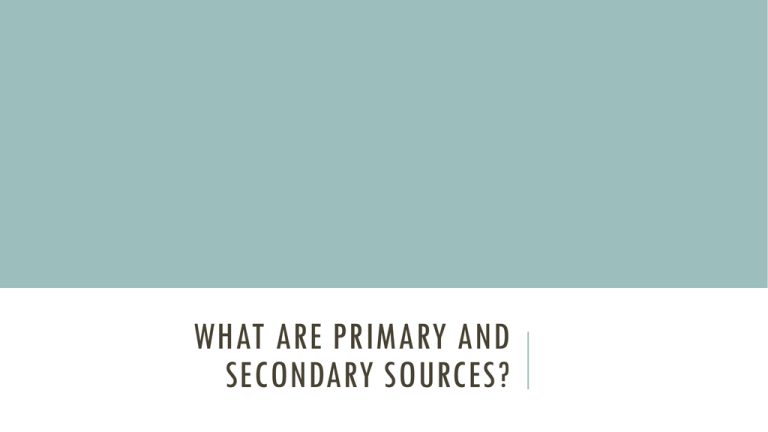
WHAT ARE PRIMARY AND SECONDARY SOURCES? WHAT IS A PRIMARY SOURCE? A primary source is an object, document, or first-hand account of an event or historical time that is being evaluated or researched. HOW TO READ A PRIMARY SOURCE ASK YOURSELF: What type of document is it? Who wrote it? When was it written? What were the historical circumstances surrounding the source’s creation? (contextualization) Who was the intended audience? Why was it written, taken, or recorded? What was the author’s purpose or goal? EXAMPLES OF PRIMARY SOURCES Diary – someone’s written account of an event. A diary is written as a way to express feelings, to provide an account of daily activities, or document a certain event. . EXAMPLES OF PRIMARY SOURCES Newspaper Article – a journalist’s written account of an event. Newspapers or magazines can be local, regional, or national in circulation, so it’s important to keep in mind how many readers a newspaper article may actually have reached, and who the intended audience was for the information given in the article EXAMPLES OF PRIMARY SOURCES Political Cartoon– usually designed to poke fun at or send a message about a certain event or person. Political Cartoons tend to be satirical in nature, so they must be carefully read to gain accurate insight into what the artist is trying to convey. EXAMPLES OF PRIMARY SOURCES Letter– a form of correspondence between people with a first-hand account of events, feelings, or stories. Letters are often personal in nature, but they can also be more formal. Some of the most poignant letters are those from soldiers writing home to their loved ones in times of war. EXAMPLES OF PRIMARY SOURCES Map – a depiction of the geography of an area. Early maps can give us an idea of what the geography of an area was like in centuries past, and they can also show what people of a certain era thought the geography of a region was like. It’s sometimes useful to compare historical maps with current maps to see what differences there are. EXAMPLES OF PRIMARY SOURCES Speech– an oration given by one person to a group of people. Speeches are often made to convince or persuade. When listening to a speech or reading the transcription of one, it’s important to understand the speaker’s purpose and who the audience was. EXAMPLES OF PRIMARY SOURCES Government Document– a document officially written by the government, like treaties and executive orders, usually spelling out rules and laws. The U.S. Constitution is one example of a government document. EXAMPLES OF PRIMARY SOURCES Photograph, Painting, or Artwork– a graphic depiction of an event, person, or object. Sometimes a painting or piece of art is meant to make a political statement. Other times, paintings are done to honor a certain person. Photographs are often taken to remember or document an event. EXAMPLES OF PRIMARY SOURCES Interview– conducted with a person to find out more information about an event or that person’s life and decisions. Interviews can be conducted oneon-one, or they can be done in a press conference format. An interview can be recorded and then transcribed to create a written record of the audio. EXAMPLES OF PRIMARY SOURCES Online Video and/or Sound Recording– can be taken to record or document an event. A sound recording can be made to document a person’s feelings on an event or situation. The sound recording could even contain background noise or be made in secret, such as a wiretap. EXAMPLES OF PRIMARY SOURCES Material Object–any tangible piece or collection from a given time period. War medals, furniture, pottery, building or structures, fossils, clothing, or even food are just a few of the many examples of objects that are primary sources. EXAMPLES OF PRIMARY SOURCES Literary or Cultural Sources – various accounts or collections of primary source information that don’t fit into another category. Some examples include novels, plays, poems, television shows, movies, essays, memoirs, or an autobiography ALWAYS CONSIDER THE SOURCE Do not think that a primary source is always objective (unbiased) or true. The person who wrote a diary, composed the article, or gave the speech was a human being with deeply felt personal opinions. A good historian will always ask questions like, “Who wrote it?”, “Why did they write it?”, and “How close were they to the event when it occurred?” Make sure the source is a reliable one. WHAT IS A SECONDARY SOURCE A secondary source is an interpretation or description of an event and/or an analysis of a primary source. HOW TO READ A SECONDARY SOURCE ASK YOURSELF: What argument is the author making? What is the author’s purpose? What types of primary sources has the author used to support the main argument? How is the author interpreting the event? Who is the audience? EXAMPLES OF SECONDARY SOURCES Textbook, Hollywood Movies, Biographies, etc. Analogy: The video of a football game PRIMARY SOURCE MATERIAL. The commentary and the endless sports talk shows after the game are SECONDARY SOURCE MATERIAL or abstractions. Abstractions are usually loaded with opinion.
